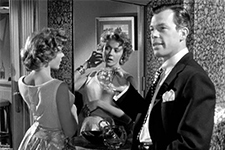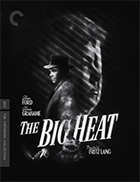The Big Heat (4K UHD)
|  In March of 1951, an estimated 30 million Americans tuned into national television broadcasts of the hearings held by the United States Senate Special Committee to Investigate Crime in Interstate Commerce, better known as the Kefauver Committee after its chairman, Senator Estes Kefauver. Through these hearings, which took place in 14 cities and included some 600 witnesses, everyday viewers became acquainted with the concept of organized crime syndicates and the widespread corruption they engendered. The hearings were so popular and widely seen that Hollywood took note, quickly churning out a number of films in subsequent years that dealt with the police tackling large criminal organizations, notably Robert Wise’s The Captive City (1952) and William Dieterle’s The Turning Point (1952). And, while it was not directly inspired by the Kefauver Committee’s hearings, their shadow looms large over Fritz Lang’s The Big Heat, whose mystery involves a crime syndicate working with corrupt police officials and politicians to run the rackets in an unnamed major city. The film begins in a methodically shocking manner, as a man shoots himself in the head while seated at the desk in his living room (this happens literally 10 seconds after the opening credits). Even though the self-inflicted violence takes place just off-screen and is entirely bloodless in keeping with the strictures of the Production Code, it is still a nastily brutal way to open a film. However, the real brutality emerges when the man’s wife (Jeanette Nolan) comes down the stairs, sees her dead husband, cooly retrieves an envelope from under his hand, and promptly goes upstairs to call the city’s crime boss, Mike Langana (Alexander Scourby), to let him know what has happened. As it turns out, the dead man was a police detective who had allowed himself to get sucked into the city’s world of organized crime and decided that the only way out was a bullet to the temple. Enter Sgt. Dave Bannion (Glenn Ford), the quintessential portrait of decency, virtue, and righteousness. Happily married to a beautiful and doting, but strongly opinionated wife (Jocelyn Brando) and father to a precocious young daughter, he is also a tireless warrior for justice, which is why the corrupt police detective’s suicide is both the perfect and worst assignment he could get: It can only lead down the rabbit hole of vice and corruption hidden behind the thin facade of respectable business. Bannion’s investigation puts him face to face with not only Langana, whose hypocrisy has him crying foul about Bannion even mentioning the word “murder” in his hallowed home, but also Langana’s sadistic muscle, a slick-haired sociopath named Vince Stone (Lee Marvin), who is always a hair-trigger away from hurting someone, usually a woman. Stone’s girlfriend, Debby Marsh (Gloria Grahame, just off her Oscar for The Bad and the Beautiful), is a fun-loving, martini-swilling dame who is smart enough to recognize the devil’s bargain she has taken to be with Stone, but also decent enough to help Bannion in his quest for justice. Of course, justice involves stepping on official toes because the kind of corruption depicted in The Big Heat has tendrils snaking into every city office, including police headquarters, which is why Bannion is relieved of his badge and forced to continue his crusade outside of official bounds. This gives the film some of its sharpest edges, as Bannion has to work beyond the law in order to enact it, but without fully sacrificing his claim to righteousness. He is like Dirty Harry with a conscience. He suffers a particularly brutal tragedy that supercharges his mission, but he is always just on the cusp of becoming the very villain he swears to bring down, which keeps the film edgy and tenuous. The Big Heat was the first film to come out of a one-year deal that Fritz Lang had signed with Columbia in early 1953. A titan of the silent-era German expressionist cinema, Lang had escaped Germany in 1933 after being approached by Hitler’s propaganda minister, Joseph Goebbels, to head the country’s film industry. He was immediately embraced by Hollywood, and he hit his stride during the war years, particularly with a series of anti-Nazi thrillers and dramas that merged the expressionistic aesthetics he had honed in the 1920s with the rules of Hollywood filmmaking. He had already worked in the realm of what was to become known as “film noir”—notably Scarlet Street (1945) and Clash by Night (1952)—but The Big Heat would quickly rise to the top of the genre, to the point that critic Pauline Kael declared it “the definitive film noir.” It came at an opportune time, as Lang’s previous films had proved to be disappointments and he was hounded by the specter of HUAC (despite his claims, Lang was never officially blacklisted, although charges of communism certainly made him sweat). The Big Heat was adapted from a novel by William P. McGivern, which had been serialized in seven parts in The Saturday Evening Post from December 1952 to February 1953. McGivern had worked as a police reporter for the Philadelphia Bulletin, and most of his novels were crime thrillers and mysteries, many of which were adapted to film and television in the 1950s, ’60s, and ’70s (he also wrote a number of original screenplays). The screenplay was penned by Sydney Boehm, who also had experience as a police reporter and had a half-dozen scripts under his belt, most of which were crime thrillers (the previous year he received his only Oscar nomination for Atomic City, a drama about an atomic scientist’s son being kidnapped). He stayed true to the general contours of McGivern’s story, although he made some notabe changes, particularly in making Bannion a more “everyday” character, rather than the erudite, educated protagonist McGivern had written. Although shot on an extremely tight schedule, The Big Heat exudes a palpable sense of menace and sadism that dovetails powerfully with its depiction of widespread corruption. The film was notable for its violence, particularly the scene in which an enraged Vince hurls a pot of boiling coffee onto Debby’s face, horribly scarring her out of vicious spite. Grahame’s performance, in this regard, is pivotal, as the impact of her scarring (which is hidden for much of the film) relies heavily on our sympathy for her, which she builds through a sly mix of sultriness, spunky humor, and humanity. The film, not surprisingly, ran into issues with the Production Code Administration from the very beginning, as the initial script was rejected because “the basic story is in violation of the Production Code.” Alas, they were able to work things out, and the completed film retains an air of incessant violence that is only marginally redeemed by the film’s coda, which finds the villains punished and Bannion returning to his desk, the idea being that corruption has been corralled and righteousness returned to his badge. This was something of an anomaly for Lang, whose films became persistently more cynical in their view of the human capacity for decency. The Big Heat, with its stark black-and-white cinematography, rogue’s gallery of corrupt officials and vicious criminals, and focus on sadistic violence, would seem to be right up that alley, but it derails pessimism by suggesting that, sometimes, just sometimes, right wins out, even if it comes with painful cost.
Copyright © 2025 James Kendrick Thoughts? E-mail James Kendrick All images copyright © The Criterion Collection | |||||||||||||||||||||||||||||
Overall Rating: 


 (3.5)
(3.5)


